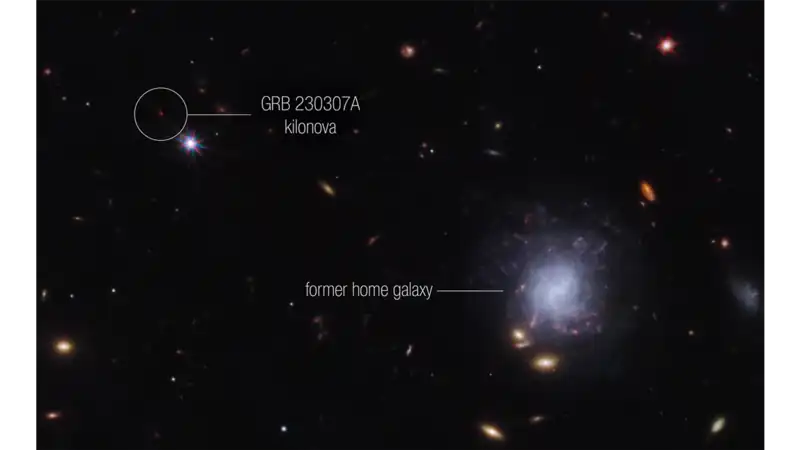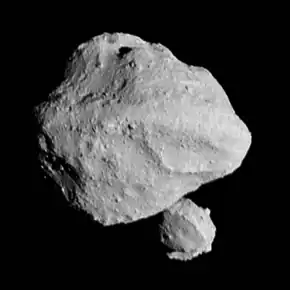 An image of GRB 230307A with the red dot on the upper left cornor being the gamma ray burst's near-infrared afterglow and the galaxy on the lower right cornor being its former home galaxy | |
| Event type | Gamma ray burst |
|---|---|
| Right ascension | 04h 03m 26.24s |
| Declination | −75° 22′ 43.82″ |
| Distance | 900 million light years (comoving) |
| Redshift | 0.065 |
| Total energy output | 10-1000 KeV |
| | |
GRB 230307A was an extremely bright, long duration gamma-ray burst (GRB), likely produced as a consequence of a neutron star merger or black hole - neutron star merger event. The gamma-ray burst was observed to have a gamma ray fluence of 3×10-4 erg cm-2 in the 10 to 1000 KeV (electronvolt) range making it second only to GRB 221009A another extremely bright and long duration gamma ray burst. This also means that it is 1000 times more powerful than typical gamma ray burst.[1] The burst had the second-highest gamma-ray fluence ever recorded.[2] The James Webb Space Telescope (JWST) detected the chemical signature for tellurium (Te).[2][3][4] The neutron stars were once part of a spiral galaxy (host galaxy) but were kicked out via gravitational interactions. Then while outside of the main galaxy at a distance of 120,000 light years, they merged, creating GRB 230307A.[4]
230307A is the second brightest gamma ray burst detected in more than 50 years of observations and is located behind the Magellanic Bridge. Despite its long duration, it is most likely the result of the compact merger of a binary ejected from a galaxy in the local universe (redshift z=0.065).[5]
The observation of the spectra of heavy elements tellurium and lanthanide was reported from the settling dust of the event.[6]
Discovery
At 15:44:06 UT on 7 Mar 2023, the Fermi Gamma-ray Burst Monitor (GBM) triggered and located GRB 230307A .[7] at the same time, the Gravitational Wave High-energy Electromagnetic Counterpart All-sky Monitor light curve shows a roughly fast rise and exponential decay (FRED) shape with a possible precursor, with a total duration of ~100 sec.[8] At 2023-03-07T15:44:09Z UT (Solar Orbiter onboard time), Spectrometer Telescope for Imaging X-rays (STIX) detected GRB 230307A. The gamma-ray burst signal can be clearly seen in the STIX quick-look light curves in the range between 10 - 84 keV. The GRB has a single peak and a duration of about 40 seconds.[9] The AGILE team also reported hours,T0 =15:44:06 (UTC)The event lasted about 30 s and it released a total number of 527069 counts in the MCAL detector (above a background rate of 1154 Hz), and 920952 counts in the AC Top detector (above a background rate of 2959 Hz).[10] The 2001 Mars Odyssey's Gamma Ray Spectrometer on Mars also reported it within 12 hours resulting in precisely estimating its incoming direction through Interplanetary Network triangulation.[11][12] Tellurium (Te) in GRB 230307A was discovered in 2023 by using the James Webb's Space Telescope's (JWST) mid infrared data. JWST obtained mid-infrared (mid-IR) imaging and spectroscopy 29 and 61 days after the burst.[13]
See also
- Christmas burst (GRB 101225A) - a 28 minute long Gamma ray burst that occurred in December 25, 2010[14]
References
- ↑ News Staff (2023-10-26). "Neutron Star Merger Observed Creating Tellurium and Other Heavy Elements | Sci.News". Sci.News: Breaking Science News. Retrieved 2023-10-27.
- 1 2 Dichiara, S.; Tsang, D.; Troja, E.; Neill, D.; Norris, J. P.; Yang, Y.-H. (2023). "A Luminous Precursor in the Extremely Bright GRB 230307A". The Astrophysical Journal Letters. 954 (1): L29. arXiv:2307.02996. Bibcode:2023ApJ...954L..29D. doi:10.3847/2041-8213/acf21d.
- ↑ O’Connor, Brendan; Troja, Eleonora; Ryan, Geoffrey; Beniamini, Paz; van Eerten, Hendrik; Granot, Jonathan; Dichiara, Simone; Ricci, Roberto; Lipunov, Vladimir; Gillanders, James H.; Gill, Ramandeep; Moss, Michael; Anand, Shreya; Andreoni, Igor; Becerra, Rosa L. (2023-06-09). "A structured jet explains the extreme GRB 221009A". Science Advances. 9 (23): eadi1405. arXiv:2302.07906. Bibcode:2023SciA....9I1405O. doi:10.1126/sciadv.adi1405. ISSN 2375-2548. PMC 10246904. PMID 37285439.
- 1 2 "NASA's Webb Makes First Detection of Heavy Element From Star Merger - NASA". 2023-10-25. Retrieved 2023-10-26.
- ↑ Mereghetti, Sandro; Rigoselli, Michela; Salvaterra, Ruben; Tiengo, Andrea; Pacholski, Dominik (2023). "XMM-Newton and INTEGRAL observations of the bright GRB 230307A : Vanishing of the local absorption and limits on the dust in the Magellanic Bridge". The Astrophysical Journal. 956 (2): 97. arXiv:2307.13514. Bibcode:2023ApJ...956...97M. doi:10.3847/1538-4357/acf846.
- ↑ Levan, Andrew; Gompertz, Benjamin P.; Salafia, Om Sharan; Bulla, Mattia; Burns, Eric; Hotokezaka, Kenta; Izzo, Luca; Lamb, Gavin P.; Malesani, Daniele B.; Oates, Samantha R.; Ravasio, Maria Edvige; Rouco Escorial, Alicia; Schneider, Benjamin; Sarin, Nikhil; Schulze, Steve (2023-10-25). "Heavy element production in a compact object merger observed by JWST". Nature. doi:10.1038/s41586-023-06759-1. ISSN 0028-0836.
- ↑ "GCN - Circulars - 33405: GRB 230307A: Fermi GBM Final Real-time Localization".
- ↑ "GCN - Circulars - 33406: GRB 230307A: GECAM detection of an extremely bright burst".
- ↑ "GCN - Circulars - 33410: Solar Orbiter STIX observation of GRB 230307A".
- ↑ "GCN - Circulars - 33412: GRB 230307A: AGILE/MCAL detection".
- ↑ works on the data from several missions and takes advantage from the detection of the same burst by different satellites and/or spacecraft equipped with GRB detectors. The principle on which the IPN is based is simple: by timing the arrival of the same burst at different spacecraft, its incoming direction can be precisely estimated.
- ↑ "GCN - Circulars - 33413: IPN triangulation of GRB 230307A (Long/Very bright)".
- ↑ JWST detection of heavy neutron capture elements in a compact object merger|https://arxiv.org/abs/2307.02098
- ↑ SVS (2015-12-24). "NASA Scientific Visualization Studio | The Christmas Burst". SVS. Retrieved 2023-10-26.
.png.webp)
